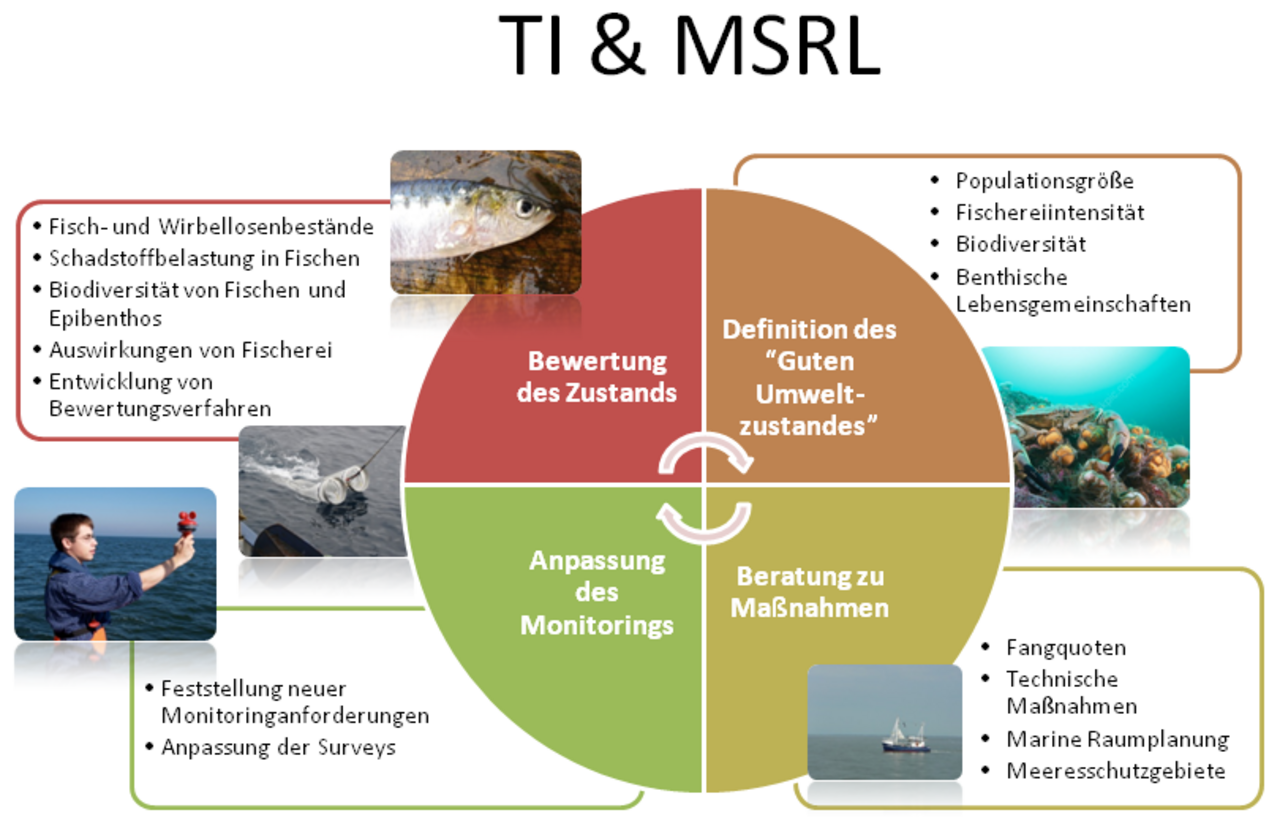Projekt
Umsetzung der Meeresstrategierahmenrichtlinie (MSRL)

Die Meerestrategie ist als Ansatz einer gesamtheitlichen Bewertung eine enorme wissenschaftliche Aufgabe: Wie kann man das marine Ökosystem mit 11 Schlagworten umreißen und bewerten? Wir entwickeln Risikomodelle, Indikatoren und integrierte Bewertungssysteme.
Hintergrund und Zielsetzung
Die Meeresstrategierahmenrichtlinie (MSRL) der Europäischen Union (EU) verpflichtet die Mitgliedstaaten, bis zum Jahr 2020 einen guten Umweltzustand (GES) zu erreichen. Die EU hat dafür elf Deskriptoren definiert, sie sollen durch Indikatoren bewertet werden. Wir erarbeiten die Operationalisierung und Bewertung von Indikatoren mit fischereilichem oder fischereiökologischem Bezug und entwickeln integrierte Bewertungssysteme. In der ersten Phase des Projektes erstellen wir eine Übersicht über die räumliche und zeitliche Verfügbarkeit von Monitoringdaten, mit denen sich relevante Indikatoren bestimmen und validieren lassen. Wesentlicher Teil dieses Arbeitsschritts ist die Operationalisierung der Indikatoren, d.h. das Festlegen von Ökosystemkomponenten und Arten sowie das Bewerten ihres Zustandes. In der zweiten Phase bestimmen wir durch Risikoanalysen den Einfluss anthropogener Belastungen auf die ermittelten Indikatoren in Abhängigkeit von räumlichen und zeitlichen Skalen. In der letzten Phase finden wir mittels der erarbeiteten Risikoanalysen Methoden zur integrierten Bewertung. Dieser Ansatz eröffnet in unterschiedlichen Szenarien politische Handlungsalternativen.
Zielgruppe
- Nationale und international politische Gremien
- Wissenschaftsgemeinde (ICES)
Vorgehensweise
Wir arbeiten in nationalen und internationalen Gremien (BLANO, ICES, EU, OSPAR) mit, beraten das BMEL, führen wissenschaftliche Analysen (Populationsmodelle, Auswertungen von Umwelt- und Fischereidaten, Entwicklung von Zustands- und Belastungsindikatoren) durch.
Daten und Methoden
- ICES DATRAS
- DCF-Daten
- TI-Surveydaten
- VMS-Daten (zur Verfügung gestellt durch die BLE)
Unsere Forschungsfragen
- Was ist der gute Umweltzustand (GES, good environmental status)?
- Anhand welcher Indikatoren kann der GES festgelegt werden?
- Wie kann der aktuelle Umweltzustand gemessen und bewertet werden?
- Wie können Einzelbewertungen von Umweltzuständen zusammen geführt werden?
Vorläufige Ergebnisse
- Entwicklung von Indikatoren zur Längenverteilung, fischereilicher Belastung benthischer Gemeinschaften und dem Zustand von Fischgemeinschaften
- Darstellung historischer Zustände der Fischgemeinschaft der südlichen Nordsee
- Methoden zur Eignungsprüfung von Indikatoren
Links und Downloads
Thünen-Ansprechperson

Thünen-Beteiligte
Beteiligte externe Thünen-Partner
-
Bundesamt für Seeschifffahrt und Hydrographie
(Hamburg, Deutschland) -
Bundesamt für Naturschutz BfN
(Bonn/Vilm, Deutschland) - Umweltbundesamt (UBA)
(Dessau-Roßlau, Deutschland)
Zeitraum
4.2010 - 12.2027
Weitere Projektdaten
Projektstatus:
läuft
Publikationen
- 0
Probst WN (2023) An approach to assess exploited fish stocks compliant to the requirements of the Marine Strategy Framework Directive (MSFD) including criterion D3C3. Ecol Indic 146:109899, DOI:10.1016/j.ecolind.2023.109899
- 1
Probst WN, Lynam CP, Bluemel JK, Clarke M (2023) Assessing change in the occurrence of rare species using the binomial distribution. Ecol Indic 156:111084, DOI:10.1016/j.ecolind.2023.111084
- 2
Bobowski BTC, Power A-M, Pierce GJ, Moreno A, Iriondo A, Valeiras J, Sokolova IM, Oesterwind D (2023) Cephalopods, a gap in the European Marine Strategy Framework Directive and their future integration. Mar Biol 170(3):26, DOI:10.1007/s00227-022-04148-2
- 3
Armelloni EN, Bergström L, Canal G, Delaunay D, Foucher E, Galatchi M, Goncalves P, Grossmann J, Hekim Z, Sand Jacobsen N, Junquera S, Kreutle A, Ligas A, Maneiro I, Mirny Z, Müller MS, Probst WN, Raicevich S, Rowe O, Saks L, et al (2022) The second workshop on lists of commercial fish and shellfish species for reporting of MSFD D3 (WKD3LISTS2). Copenhagen: ICES, iii, 131 p, ICES Sci Rep 4(80), DOI:10.17895/ices.pub.21318255
- 4
Probst WN, Stelzenmüller V, Rambo H, Moriarty M, Greenstreet SPR (2021) Identifying core areas for mobile species in space and time: A case study of the demersal fish community in the North Sea. Biol Conserv 254:108946, DOI:10.1016/j.biocon.2020.108946
- 5
Probst WN, Kempf A, Taylor MH, Martinez I, Miller D (2021) Six steps to produce stock assessments for the Marine Strategy Framework Directive compliant with Descriptor 3. ICES J Mar Sci 78(4):1229-1240, DOI:10.1093/icesjms/fsaa244
- 6
Belgrano A, Lynam CP, Probst WN, Thompson M, Doyle A, Brind'Amour A, Beauchard O, Piet GJ, Schratzberger M, Jacob U, Eerkes-Medrano D, Somerfield PJ, Laffargue P, Fu C, Ellingsen K, Garcia C, Couce E, Clarke M, Artigas F, Salter I, et al (2021) Working Group on Biodiversity Science (WGBIODIV). Copenhagen: ICES, 57 p, ICES Sci Rep 3(79), DOI:10.17895/ices.pub.8247
- 7
Rindorf A, Arronte JC, Baldo F, Börjesson P, Calderwood J, Charisiadou S, Burgos MC, Eerkes-Medrano D, Goncalves P, Kavanagh A, Kempf J, Lefkaditou E, Lynam CP, Machado I, Mildenberger TK, Moura T, Probst WN, Reid D, Salvany L, Sys K, et al (2021) Workshop on the production of abundance estimates for sensitive species (WKABSENS). Copenhagen: ICES, 128 p, ICES Sci Rep 3(96), DOI:10.17895/ices.pub.8299
- 8
Clarke M, Alves A, Arceredillo AT, Guijarro B, Perales Raya C, Konrad C, Delaunay D, Voces D, Miller D, Glyki E, Balestri E, Foucher E, Nixon E, Boer Fde, Kelly F, Velasco F, Tiganov G, Carruel G, Wennhage H, Probst WN, et al (2020) Workshop to review and progress the reported lists of EU MSFD Descriptor (WKD3Lists). Copenhagen: ICES, 128 p, ICES Sci Rep 2(82), DOI:10.17895/ices.pub.7467
- 9
Froese R, Winker H, Coro G, Demirel N, Tsikliras AC, Dimarchopoulou D, Scarcella G, Probst WN, Dureuil M, Pauly D (2018) A new approach for estimating stock status from length frequency data. ICES J Mar Sci 75(6):2004-2015, DOI:10.1093/icesjms/fsy078
- 10
Probst WN, Rau A, Oesterwind D (2016) A proposal for restructuring descriptor 3 of the Marine Strategy Framework Directive (MSFD). Mar Policy 74:128-135, DOI:10.1016/j.marpol.2016.09.026
- 11
Probst WN, Lynam CP (2016) Integrated assessment results depend on aggregation method and framework structure - a case study within the European Marine Strategy Framework Directive. Ecol Indic 61:871-881
- 12
Probst WN, Stelzenmüller V (2015) A benchmarking and assessment framework to operationalise ecological indicators based on time series analysis. Ecol Indic 55:94-106, DOI:10.1016/j.ecolind.2015.02.035
- 13
Shephard S, Hal R van, de Boois IJ, Birchenough SNR, Foden J, O'Connor J, Geelhoed SCV, Hoey G van, Marco-Rius F, Reid DG, Schaber M (2015) Making progress towards integration of existing sampling activities to establish Joint Montoring Programmes in support of the MSFD. Mar Policy 59:105-111, DOI:10.1016/j.marpol.2015.06.004
- 14
Probst WN, Rau A, Diekmann R, Dorrien C von, Seidel H, Fock HO, Kraus G, Stelzenmüller V (2014) Eine Thünen-Evaluierung von fisch- und fischereibezogenen Indikatoren der EU Meeresstrategie-Rahmenrichtlinie (MSRL). Hamburg: Johann Heinrich von Thünen-Institut, 106 p, Thünen Working Paper 25, DOI:10.3220/WP_25_2014
https://literatur.thuenen.de/digbib_extern/bitv/dn053653.pdf
- 15
Probst WN, Oesterwind D (2014) How good are alternative indicators for spawning-stockbiomass (SSB) and fishing mortality (F)? ICES J Mar Sci 71(5):1137-1141, doi:10.1093/icesjms/fst207
- 16
Zampoukas N, Palialekis A, Duffek A, Graveland J, Giorgi G, Hagebro C, Hanke G, KorpinenS, Tasker M, Tornero V, Abaza V, Battaglia P, Caparis M, Dekeling R, Frias Vega M, Haarich M, Katsanevakis S, Klein H, Krzyninski W, Probst WN, et al (2014) Technical guidance on monitoring for the Marine Strategy Framework Directive. Luxembourg: Publications Office of the European Union, 166 p, doi:10.2788/70344
- 17
Probst WN, Stelzenmüller V, Kraus G (2013) A simulation-approach to assess the size structure of commercially exploited fish populations within the European Marine Strategy Framework Directive. Ecol Indic 24:621-632, DOI:10.1016/j.ecolind.2012.08.026
- 18
Probst WN, Kloppmann MHF, Kraus G (2013) Indicator-based status assessment of commercial fish species in the North Sea according to the EU Marine Strategy Framework Directive (MSFD). ICES J Mar Sci 70(3):694-706, doi:10.1093/icesjms/fst010
- 19
Probst WN, Stelzenmüller V, Fock HO (2012) Using cross-correlations to assess the relationship between time-lagged pressure and state indicators: an exemplary analysis of North Sea fish population indicators. ICES J Mar Sci 69(4):670-681, doi:10.1093/icesjms/fss015

